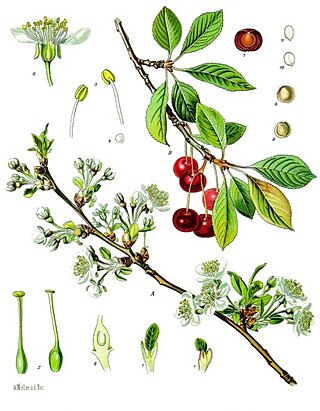
Prunus cerasus is a species of Prunus in the subgenus Cerasus (cherries), native to much of Europe, North Africa and West Asia. It is closely related to the sweet cherry, but has a fruit that is more acidic. Its sour pulp is edible.
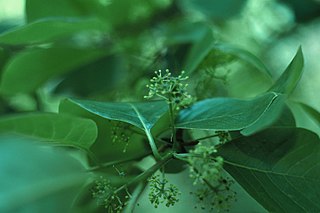
Tupelo, genus Nyssa, is a small genus of deciduous trees with alternate, simple leaves. It is sometimes included in the subfamily Nyssoideae of the dogwood family, Cornaceae, but is placed by other authorities in the family Nyssaceae. In the APG IV system, it is placed in Nyssaceae.
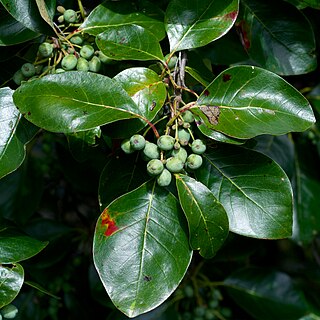
Nyssa sylvatica, commonly known as tupelo, black tupelo, black gum or sour gum, is a medium-sized deciduous tree native to eastern North America from the coastal Northeastern United States and southern Ontario south to central Florida and eastern Texas, as well as Mexico.

A beehive is an enclosed structure in which some honey bee species of the subgenus Apis live and raise their young. Though the word beehive is used to describe the nest of any bee colony, scientific and professional literature distinguishes nest from hive. Nest is used to discuss colonies that house themselves in natural or artificial cavities or are hanging and exposed. The term hive is used to describe an artificial/man-made structure to house a honey bee nest. Several species of Apis live in colonies. But for honey production, the western honey bee and the eastern honey bee are the main species kept in hives.
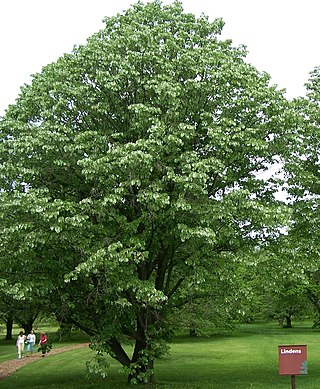
Tilia is a genus of about 30 species of trees or bushes, native throughout most of the temperate Northern Hemisphere. The tree is known as linden for the European species, and basswood for North American species. In Britain and Ireland they are commonly called lime trees, although they are not related to the citrus lime. The genus occurs in Europe and eastern North America, but the greatest species diversity is found in Asia. In Chinese, "椴/duàn" or "椴樹/duànshù" is a general term for Tilia species. Under the Cronquist classification system, this genus was placed in the family Tiliaceae, but genetic research summarised by the Angiosperm Phylogeny Group has resulted in the incorporation of this genus, and of most of the previous family, into the Malvaceae.

Jujube, sometimes jujuba, known by the scientific name Ziziphus jujuba and also called red date, Chinese date, and Chinese jujube, is a species in the genus Ziziphus in the buckthorn family Rhamnaceae.

Pollination of fruit trees is required to produce seeds with surrounding fruit. It is the process of moving pollen from the anther to the stigma, either in the same flower or in another flower. Some tree species, including many fruit trees, do not produce fruit from self-pollination, so pollinizer trees are planted in orchards.

The Pyralidae, commonly called pyralid moths, snout moths or grass moths, are a family of Lepidoptera in the ditrysian superfamily Pyraloidea. In many classifications, the grass moths (Crambidae) are included in the Pyralidae as a subfamily, making the combined group one of the largest families in the Lepidoptera. The latest review by Eugene G. Munroe and Maria Alma Solis retain the Crambidae as a full family of Pyraloidea.

Vaccinium angustifolium, commonly known as the wild lowbush blueberry, is a species of blueberry native to eastern and central Canada and the northeastern United States, growing as far south as the Great Smoky Mountains and west to the Great Lakes region. Vaccinium angustifolium is the most common species of the commercially used wild blueberries and is considered the "low sweet" berry.

Acherontia styx, the lesser death's head hawkmoth or bee robber, is a sphingid moth found in Asia, one of the three species of death's-head hawkmoth. It is very fond of honey, and bee keepers have reported finding dead moths in their hives as a result of bee stings. They can mimic the scent of bees so that they can enter a hive unharmed to get honey. Their tongue, which is stout and very strong, enables them to pierce the wax cells of the beehive and suck the honey out. They are also known to be a pest of yuzu in South Korea, using their tongue to pierce and damage the fruit.

Citrus × aurantium f. aurantium(Syn: Citrus× sinensis), a hybrid between pomelo and mandarin, also known as the sweet oranges, is a commonly cultivated species of orange that includes Valencia oranges, blood oranges and navel oranges.

Eudocima cocalus, the cocalus fruit piercing moth, is a moth of the family Erebidae. It is found in the north-eastern part of the Himalaya, to Sundaland and east to Queensland, Australia and the Solomons.
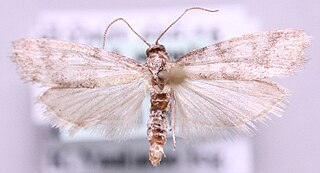
Vitula biviella is a species of snout moth in the genus Vitula. It was described by Zeller in 1848. It is found in most of Europe, except Ireland and the southern part of the Balkan Peninsula. It is only recently present in Great Britain. The first records were noted in 1997 and 1998 from Kent and the species now seems to have established small breeding populations in both Kent and Suffolk.
Vitula setonella is a species of snout moth in the genus Vitula. It was described by James Halliday McDunnough in 1927. It is found in British Columbia, Utah, California and Arizona.
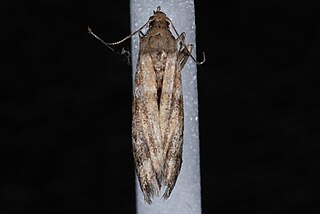
Vitula broweri, or Brower's vitula moth, is a species of snout moth in the genus Vitula. It was described by Carl Heinrich in 1956. It is found in much of North America, including British Columbia, Manitoba, Maryland, Massachusetts, Ohio, Oklahoma, Ontario, Tennessee, West Virginia and Wisconsin.
Vitula insula is a species of snout moth. It was described by Herbert H. Neunzig in 1990. It is found in the US state of California.
Vitula lugubrella is a species of snout moth in the genus Vitula. It was described by Émile Louis Ragonot in 1887. It is found in North America, including California.
Vitula pinei is a species of snout moth in the genus Vitula. It was described by Carl Heinrich in 1956. It is found in the US states of California, Arizona, Texas and Utah.

Hygrocybe reidii, commonly known as the honey waxcap, is a mushroom of the waxcap genus Hygrocybe. It was published by Robert Kühner in 1976, with the specific epithet honouring British mycologist Derek Reid. It is based on a species originally published as Hygrophorus marchii by Giacomo Bresadola in 1928, but with an insufficiently precise description, which later led to conflicting interpretations about the species concept. In 1969, Reid gave a precise description of the fungus common in Europe, but Kühner had a different interpretation of H. marchii, and gave a new name to Reid's concept of the species.




















